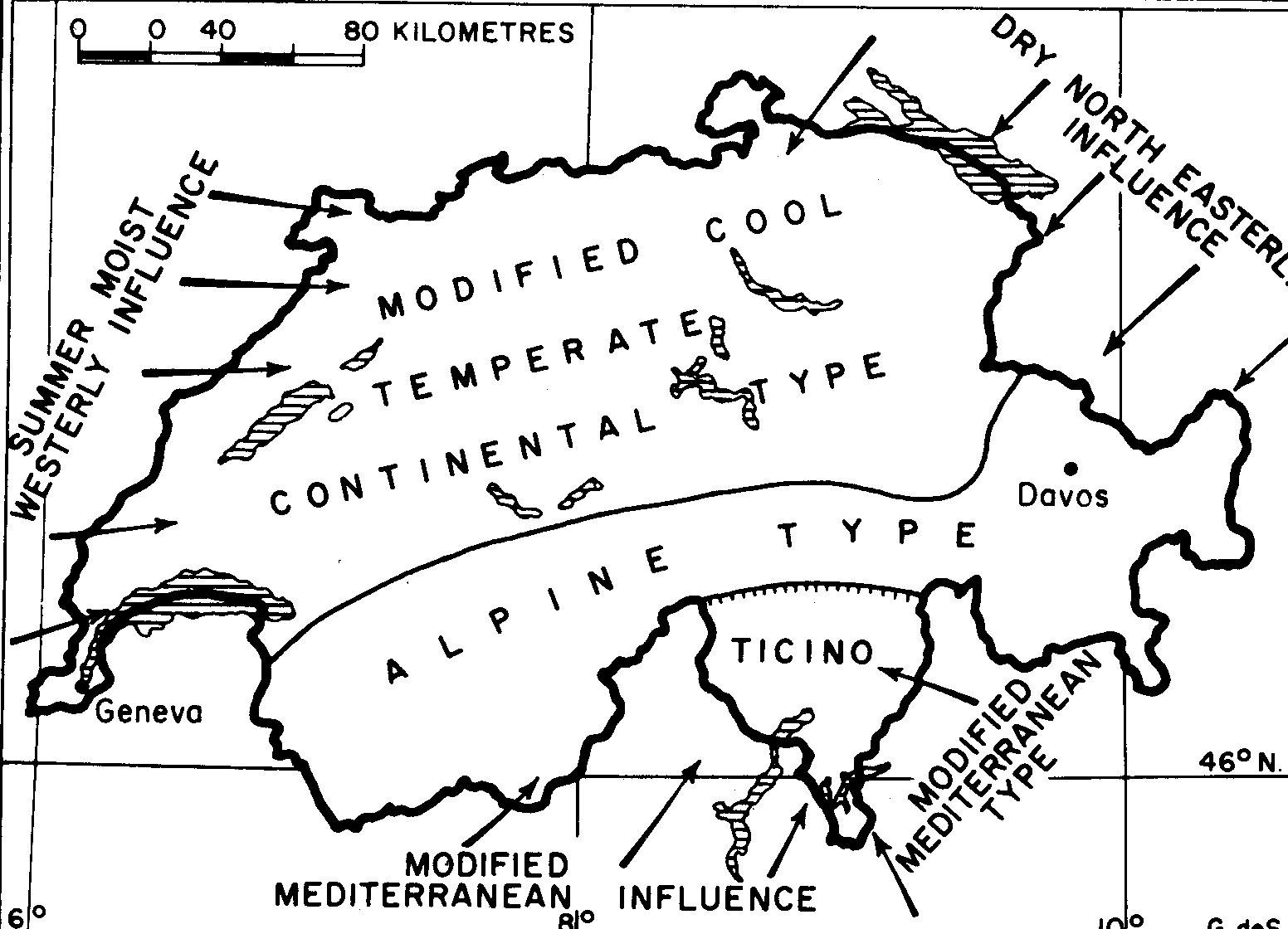Switzerland: The Climate
The climate of Switzerland is temperate, but varies with altitude. Winters are cold, cloudy, rainy/snowy. Summers are cool to warm, cloudy, humid with occasional showers. The climate of Switzerland is complex. It is as a result of internal and external influences such as altitude, that a number of regional and local climates, can be identified in Switzerland. The country is therefore an area of micro-climates.
A number of factors have contributed to the diversity in Switzerland's climate and these include the following:
Location of Switzerland: Switzerland lies 46° N of the Equator thus making it a temperate country. It therefore climatic characteristics that are associated with areas found in the temperate region. Such climatic characteristics include low temperatures and precipitation that is receive snow in places where temperatures fall below 0° as well as a four-seasonal pattern in form of Winter, autumn, spring and summer.
There is precipitation throughout the year and the summer maximum rainfall can be between 120-180cm of rainfall while in winter, much of the precipitation is in form of snow. In summer, the temperatures can be between 16°C-21°C while in winter, they fall below 0°C. The growing of crops given the climatic pattern is restricted to spring time- between April and August.
.png) Air
mass: An air mass is a form of wind
blowing in a specific direction. There are basically three air masses that
influence the climate of Switzerland. These air masses are an external
influence and therefore affect Switzerland in a different ways. The movement of
winds is determined by changes in pressure.
Air
mass: An air mass is a form of wind
blowing in a specific direction. There are basically three air masses that
influence the climate of Switzerland. These air masses are an external
influence and therefore affect Switzerland in a different ways. The movement of
winds is determined by changes in pressure.
Eastern Switzerland experiences a warm airmass. It is usually dry and leads to the melting of snow in winter and early spring. It enables the people to go outdoors. However, this kind of situation causes another problem of avalanches.
An avalanche is a large mass of snow falling from highland areas to lowland areas. They destroy roads, peoples' property and their lives. This warm dry wind is referred to as fohn air mass.
Another air mass that affects the climate of Switzerland comes from Germany. This is a cold airmass and leads to cold conditions. This in flowing air from the North and the Northeast blows throughout the year and is responsible for the hazy conditions experienced during, summer.
From France, there is a warm air mass which tends to moderate the climatic conditions in the adjacent areas. It also leads to rainy conditions during summer and in winter the conditions are not so cold.
The effect of altitude: Some parts of Switzerland are above 2500 metres. While some few others go beyond 4000m. This high level of altitude and relief induces high rainfall. The temperate location together with altitude are responsible for very cold conditions at high altitude thus permanent snow cover on the upper slopes of the mountains.
Low altitude areas on the other hand experience mild conditions. The foothills and valleys of mountains remain dry receiving only snowmelt streams.
.png) Aspect:
Aspect is the position of a region in
relation to the rays of the sun. In the highland areas, some parts may receive
the sun rays while others may not. In the temperate regions especially the
Northern Hemisphere, the South facing slopes are warmer than the north facing
slopes. This is because the sun rays come from the South then directly affect
the south facing slopes. It is for this reason that much of the settlement is
concentrated on the south facing slopes.
Aspect:
Aspect is the position of a region in
relation to the rays of the sun. In the highland areas, some parts may receive
the sun rays while others may not. In the temperate regions especially the
Northern Hemisphere, the South facing slopes are warmer than the north facing
slopes. This is because the sun rays come from the South then directly affect
the south facing slopes. It is for this reason that much of the settlement is
concentrated on the south facing slopes.
Temperature inversion: Temperature inversion is a process by which warm air, which rises from the valley, is replaced by cool air. The trend therefore changes that instead of the valley being warmer, it becomes cooler.
Most winter temperatures in the valleys are largely influenced by temperature inversion. During winter as the air in the valleys is warmed up, it rises thus creating a vacuum.
A cool dense air from the surrounding region then descends in the valley to fill up that vacuum. The process is continuous and leads to cooler conditions in the valley when compared to the middle parts of the slope.
Map of Switzerland Showing Winds
Influencing Climate
